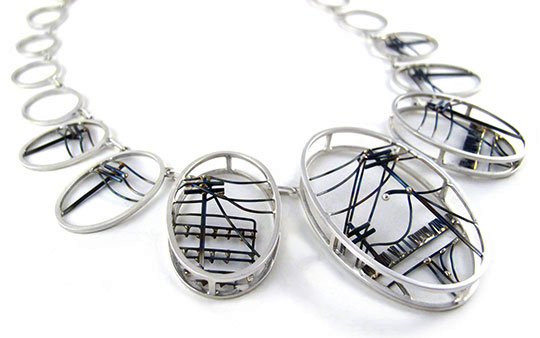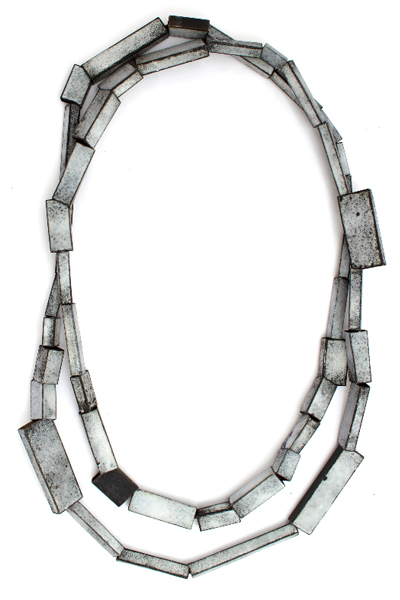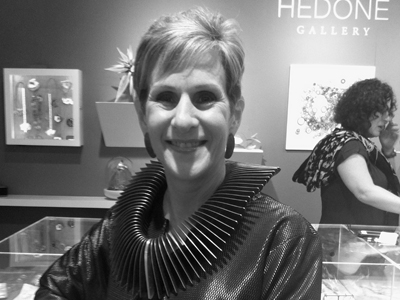Bonnie Levine: I’m always intrigued by the themes of Taboo Studio’s group shows. Last year there were: Of Two Minds, Out of the Blue, Over the Moon, and Together Again. This current show also has a provocative theme: Between the Lines. How do you and co-owner Joanna Rhoades come up with the concepts and ideas for the shows?
Jane Groover: The concepts and ideas for our exhibitions usually come from an idea that has been brewing in my mind. We finalize details with a consensus among Joanna and me and our gallery assistant, Christina Seebold. We like our titles to relate to the work, of course, but we also like them to be compelling. Out of the Blue was one of my favorites simply because a lot of work in the exhibition was blue in color, but some of the work was literally out of the blue, unexpected and unanticipated and not blue.
When you asked the six artists to interpret this theme, did you have something specific in mind—like the literal use of line as technique—or something more abstract and not explicitly stated as the phrase implies?
Jane Groover: We chose the title Between the Lines because of its directness. All of the artists in this exhibition make jewelry that focuses on line, but how they interpret line in their work is what makes it most intriguing. We wanted to leave the door open to that strength; consequently, the work in the exhibition includes a stunning array of geometric, organic, and pictoral line.
Kat, tell us about your background and how you became interested in being a jeweler.
Kat Cole: I had been planning to become a ceramics major when I began my undergraduate work at Virginia Commonwealth University, but it was full and I ended up taking a beginning jewelry class with Jim Meyer instead and never looked back. A seemingly endless range of techniques to be mastered in the intimate scale of jewelry drew me in. During my last semester of undergraduate, Helen Carnac came for a week as a visiting artist to teach us enameling. So I was introduced to working with steel and enamel as a combo from early on, and I really attribute that experience to the direction my work took a few years later.
Your work is inspired by the places you live and your journey to find “home.” How is this expressed in your jewelry?
Kat Cole: I use my creative process in the studio to help develop a connection between me and the places I am living. This process forces me to be more observant and document what is around me: the domestic and industrial building structures, roadways, color palette, history of the place, and people who live there. All of these details get filtered through me and out into my work. The outcome is sometimes quite literal and uses images and found objects of that place; other times the pieces are quite abstract and do not offer such a clear narrative.
You’ve lived in eight states and now reside in the very urban city of Dallas, Texas, USA. How have these moves changed or influenced your work?
Kat Cole: My work has made a shift with every move, changing as my visual landscape does. When I first came to Dallas, I was living right downtown. The skyscrapers, windows, air conditioner units, and trucks on the street are all rectangles, it’s constant repetition of a singular shape. My work has become larger and more abstract since my move here. I’ve been doing research into this city’s history, the way it has been shaped by water, cattle, and oil, and will be exploring this in my next body of work.

What does the theme of the current show Between the Lines mean to you? Is this concept a hallmark of your work in general, or did you interpret it in a new or different way for this show?
Kat Cole: I am really honored to be exhibiting with such a great lineup of talented artists. When I looked at the roster, I noticed that everyone already had some sense of line quality to their work, including my own. The piece used on the postcard, The Outer Loop, was made for the show. The title is a nod to the rather epic interstate system here in Dallas; it loops and circles the city much the same way this piece does the wearer’s neck. I wanted to make a piece for the show really using the line to emphasize the body in different ways. It can be worn the length of the torso, doubled down the chest, or clustered three times around the neck.
Donna, you have a background in design and have taught at three schools. Why did you give that up and become a full-time maker?
Donna D’Aquino: I originally went to school for graphic design. I wanted to be an illustrator. I had a three-dimensional design teacher who told me I would take his intro to jewelry class the next semester. I said I would not, he said I would, and so it went on for the rest of the semester. I am sure you can see who won this argument. Upon graduation, I did not feel that I had all the tools and skills to go out into the world and make a living. After about eight years of working in various jobs, I returned to school for my MFA with the intention of teaching when I graduated. I was fortunate to have received a graduate teaching assistant position at Kent State University, and this really prepared me to teach. When I entered graduate school, I promised myself I would also work on a line of jewelry that I hoped would sell. If I wasn’t able to get a teaching job, I wanted to be as prepared as possible so I did not have to work for someone else. I scheduled my first craft show about three weeks after I completed my thesis.
I had heard so many stories about people not being able to make work for a year after completion of their thesis, and I didn’t want this to happen to me. Upon graduation from my MFA, I began to “chase” the teaching job. While doing this, I also began to do craft shows. I knew at some point in time I would need to make a choice. I realized about four years in that I was not giving either 100% of my efforts. I loved being in the classroom with my students, yet it was also exciting to see customers purchasing and supporting the jewelry I was making. I eventually decided to take the leap into being a full-time maker. The thing that mostly made the decision for me was that my business was taking in more money than my teaching salary and I felt like I wasn’t even trying. I wanted to give one thing all my energy to see what could come from it. I am happy to say that I am entering slowly back into teaching through workshops. I had the honor to teach at Haystack just this past weekend. It reminded me of all the things I loved about teaching. I am hoping to do more of it.
Your work is all about repeating geometric patterns, lines, volume, space, form, and structure. What inspires and influences your work?
Donna D’Aquino: I grew up about 70 miles north of New York City in the Hudson valley and have always been drawn to the structural aspects in architecture. I am intrigued by bridges, telephone towers, water towers, and scaffolding; to the repetition of lines, shapes, and patterns, and how they all relate to each other and the environment around them; and to how they are held together—their strengths and their weaknesses.
I have also always been interested in the ideas of pushing the boundaries of what “is” jewelry and the ideas behind using very nonprecious materials; questioning what gives jewelry value and who gives jewelry value. This is an ongoing question in my mind. I am hoping to make the viewer question and maybe think about jewelry in a different way.
I’ve seen your work described as “organized chaos,” and it reminds me of three-dimensional doodles that somehow come together as wearable jewelry and sculptural objects. How do you bring your work to life, so to speak, and do you have a predetermined plan for each piece or series?
Donna D’Aquino: When I originally studied both design and jewelry, I was taught (I think I was “taught” this) or I believed that I always had to have a plan for the final outcome of an idea. I was trained fairly traditionally, setting stones and using precious materials. I would make painstaking drawings and models of what I was building in metal.
When I started working in wire, primarily the steel wire, everything changed. I was handed wire and told to “draw.” This changed the way I thought about my process. It brought together the things I loved—drawing and making in a three-dimensional way. I used the wire as I would use a pencil or charcoal line. The object became my drawing. I would start with a basic idea or concept and then let it evolve, intuitively. I would think, “this will be a circle or a square.” I would then proceed to make parts. Eventually, when I had enough layers, I would begin to put them together. I would tie them and bind them to each other, pushing and pulling the layers. I was continually looking at and thinking about their relationship to each other. The pieces would evolve from this process. I would document them after by doing a quick sketch of them in my sketchbook.
Does the theme Between the Lines have a particular meaning to you in relationship to your work? Did you rethink your work in relationship to the line or the parts in between for this show?
Donna D’Aquino: Between the Lines is a perfect theme for my work. I did not necessarily have to rethink the concept. My work involves so much negative space. Truly, my work is as much about the negative space as it is the positive. When making the work, I am focused on the linear aspect of it. There is no denying the negative space “between the lines.” These areas are as important as the linear portion. One does not exist without the other.
Thank you.





